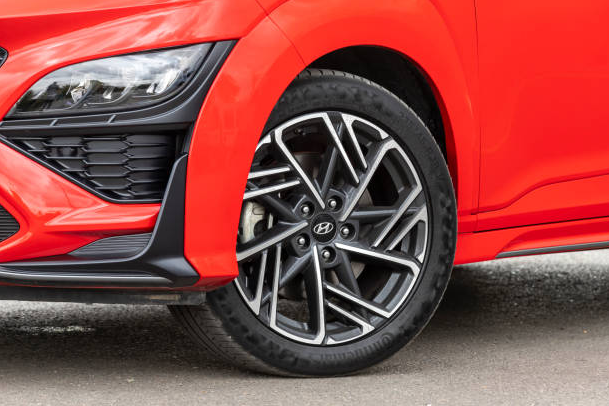According to Hyundai, the recommended tire pressure for the Hyundai Kona is 33 psi for both the front and rear tires (this includes models from 2018 to 2022) and 60 psi for the spare tires.
This tire pressure applies if you are inflating the original tires that came with the vehicle. The recommended psi value would slightly differ if you replaced the original tires.
It would be best to look at your owner’s manual or the sticker attached to the door panel on the driver’s side for the manufacturer’s recommendation.
The tricky part about inflating Hyundai Kona tires is that too little air can result in poor fuel economy and gas mileage, while too much air can cause the car to bounce around, possibly leading to a flat tire. So it would help if you had the right tire pressure for your particular Kona model.
Table of Contents
Tire Pressure Table For Hyundai Kona Models And Tire Size
| Recommended Tire pressure | |||
| Hyundai Kona Year Model | Tire Size | Front tire | Rear tire |
| 2022 | 205/60R16 92H | 33 psi | 33 psi |
| 215/55R17 94V | |||
| 235/45R18/XL 98V | |||
| 2021 | 205/60R16 92H | 33 psi | 33 psi |
| 215/55R17 94V | |||
| 235/45R18/XL 98V | |||
| 2020 | 205/60R16 92H | 33 psi | 33 psi |
| 215/55R17 94V | |||
| 235/45R18 94V | |||
| 235/45R18/XL 98V | |||
| 2019 | 205/60R16 92H | 33 psi | 33 psi |
| 215/55R17 94V | |||
| 235/45R18 94V | |||
| 235/45R18/XL 98V | |||
| 2018 | 205/60R16 92H | 33 psi | 33 psi |
| 215/55R17 94V | |||
| 235/45R18 94V | |||
| 235/45R18/XL 98V | |||
| Kona Limited | 235/45R18 94V | 33 psi | 33 psi |
| 235/45R18 98V XL | |||
| Kona N Line | 235/45R18 98V XL | 33 psi | 33 psi |
| Kona SE | 205/60R16 92H 33 | 33 psi | 33 psi |
| Kona SEL | 215/55R17 94V | 33 psi | 33 psi |
| Plus | 215/55R17 94V | 33 psi | 33 psi |
| Kona Ultimate | 235/45R18 94V | 33 psi | 33 psi |
| 235/45R18 98V XL | |||
How Do I Find The Tire Pressure For My Hyundai Kona?
In your owner’s manual, in the “Vehicle Information” section, you will find the tire pressure alongside other essentials like the best gasoline or fuel for your vehicle.
You can also navigate the Hyundai Resources online page to find your Hyundai Kona owner’s manual.
Another way to find out the right tire pressure for inflating your Kona tires is by checking the PSI recommendation printed on the sticker on the frame of the driver’s door.
Remember that the PSI values on your tire’s sidewall represent the maximum pressure the tires can withstand at high speeds, so it is generally not safe to inflate your tires to the number printed on the tire’s sidewall.
Can I Use A Different Pressure On My Kona?
While it is recommended to stick to the recommended tire pressure for your Hyundai Kona as specified in the manual, there are some circumstances where it is safe to deviate.
For example, if you ride on the side, you would want your vehicle to gain more contact with the field to improve traction. To achieve this, you have to lower the tire pressure to 15 PSI., but don’t forget to inflate it back to the standard PSI when you get back on a hard floor.
Also, you can increase the tire pressure on your Kona when fuel economy is very important. You can save fuel by maintaining a pressure of 3 or 4 PSI while driving around a large city.
How To Check Tire Inflation Pressure On Hyundai Kona
Hyundai recommends that you check your tire at least once a month. You can do this using a good-quality tire pressure gauge.
Step 1: Remove the valve cap from the tire valve stem.
Step 2: Press the tire gauge firmly onto the valve and observe the pressure measurement on the gauge display.
Step 3: Confirm that the cold tire inflation pressure corresponds with the recommended pressure on the tire and loading information label. If it does, then you are good to go.
Step 4: If the PSI is lower, add air using a tire inflator until the pressure reaches the recommended value.
Step 5: Return the valve caps on the valve stems to prevent dirt or moisture from getting into the valve core and causing air leakage.
Final Thoughts
Now that you know the ideal tire pressure for your Hyundai Kona ensure that you inspect them at least once a month to maintain proper inflation and prevent wear and damage.
If you are still unsure about the right cold tire pressure for your vehicle, double-check the information on the tire label on the driver’s side center pillar.
Also, it is advised to check the pressure of the spare every time you test other tires to ensure an equal inflation level and avoid uneven wear.
If you notice that any of your Hyundai Kona tires are worn or damaged, replace them with the same size, type, construction, and tread pattern.
It is generally not safe to replace Kona tires with different specifications; this could result in poor vehicle control or even damage to the ABS of the Hyundai.

